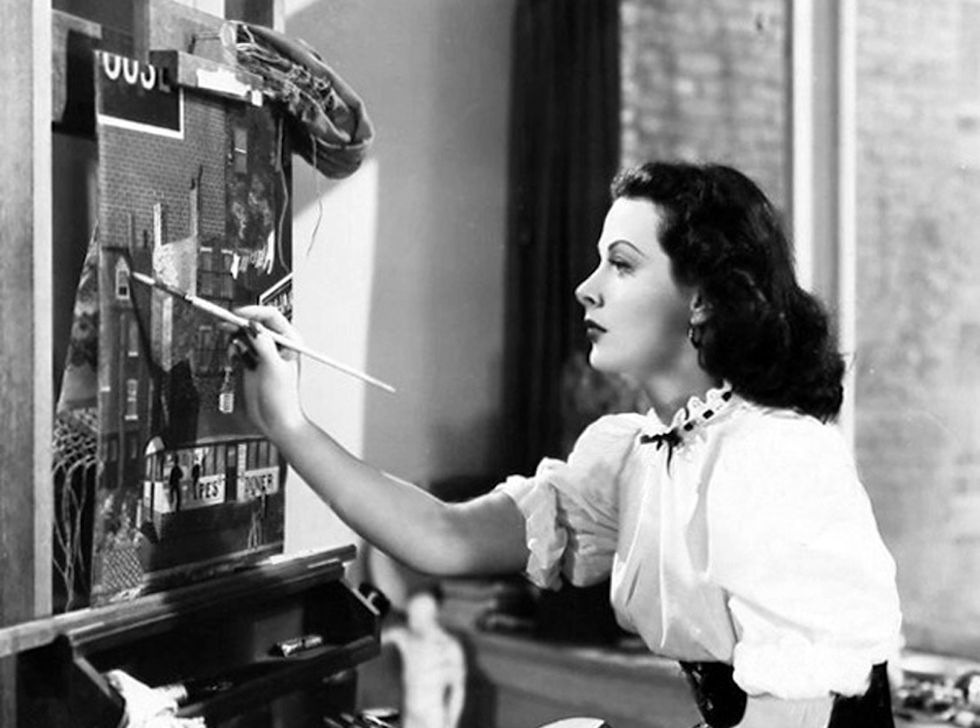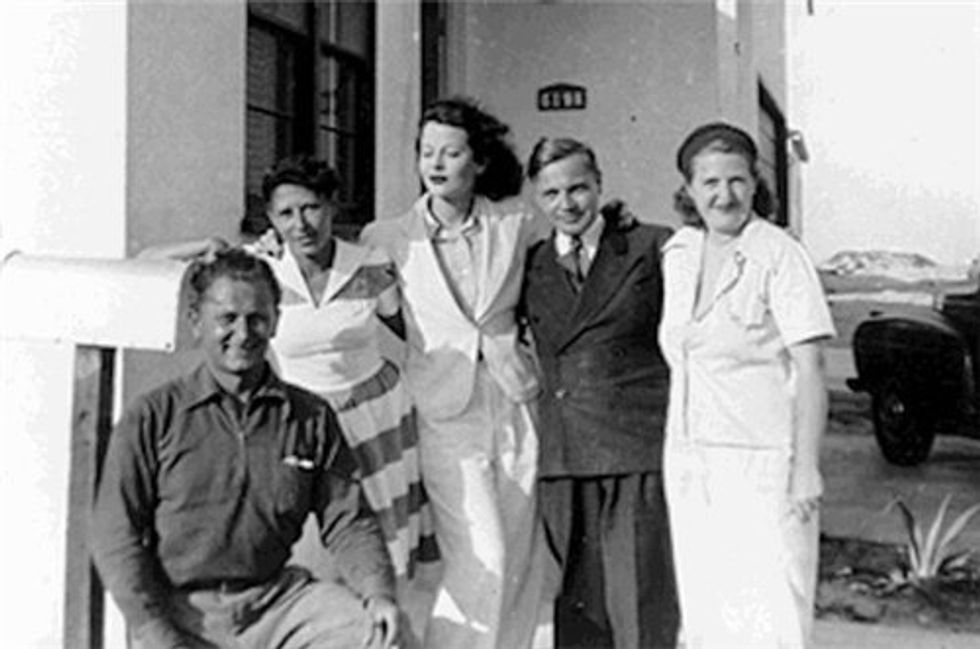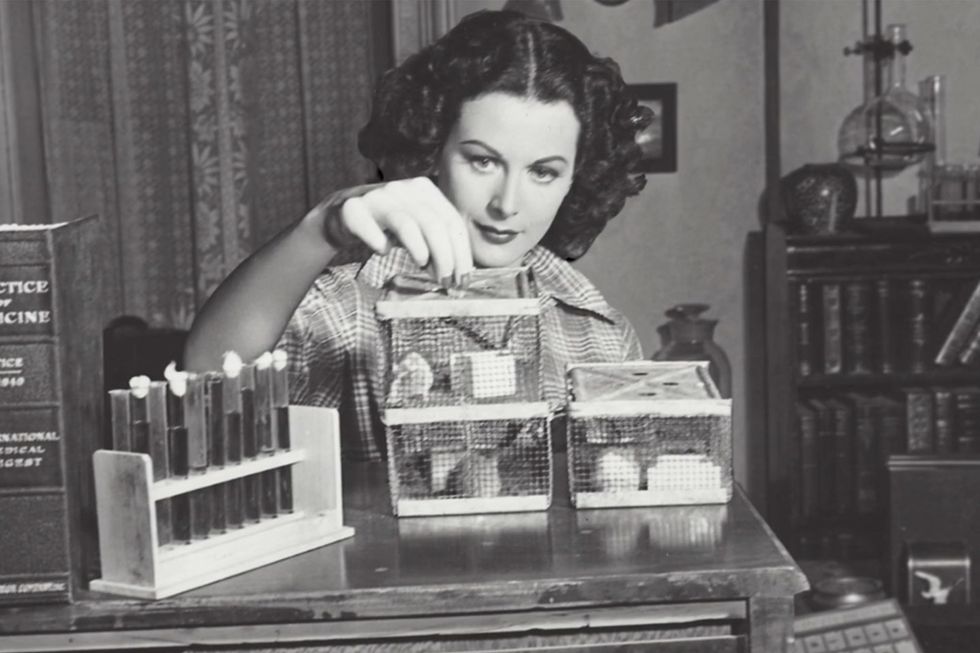During Hedy Lamarr's time in the spotlight as an "Old Hollywood" starlet, she was branded as "the most beautiful woman in the world." But Lamarr herself sneered at the concept of "star appeal" in Hollywood.
"Any girl can be glamorous," she said. "All she has to do is stand still and look stupid."
Whenever I hear this quote, her role in 1940's "Ziegfeld Girl" (pictured above) always comes to mind. "Ziegfeld Girls," if you don't already know, were showgirls in "Ziegfeld Follies," a long-running Broadway production from the 1900's through the 1930's. They were similar to today's Radio City Rockettes, but Ziegfeld Girls did not dance (or sing) on stage. They were merely ornaments to be gazed upon.
Hedy Lamarr took on this role of a Ziegfeld Girl in an MGM film, and was adorned with the ensemble of a sparking headdress and gown that would become part of her legacy forever. But off-camera, she was SO much more than an object of beauty. While filming "Ziegfeld Girl," revolutionary ideas were swirling around in her head.
But for this story to make sense, let's back up a little...
Hedy Before Hollywood
In Austria during the 1930's, teenage Hedy Kiesler began her acting career, and soon became notorious for one film in particular: “Ecstasy." This 1933 film, directed by a Czech filmmaker, was SO ahead of its time—by featuring nudity and themes of sexual liberation.
But with the tight social values of the 1930's, the film caused a public scandal, embarrassing Kiesler and her family. So when she was being courted by Fritz Mandl, a wealthy Austrian weapons mogul , she decided to take a break from acting and married him during the summer of 1933 at the age of eighteen.
Their four-year marriage turned toxic quickly. Mandl, whose major clients for munitions were Mussolini and Hitler, applied the ideas of Fascism to his marriage. He forbade Kiesler from continuing her acting career—and wouldn't even allow her to leave the house without supervision. The staff was also ordered to keep her from leaving the estate at all when he was away on business.
Mandl also controlled Kiesler's allowances, and kept her jewelry locked up when she was not wearing it. As she described it herself, Kiesler said she felt like a “doll in a beautiful jeweled case" and trapped in a “prison of gold". But she also had a plan.
On the outside, Hedy Kiesler acted like the perfect trophy wife. But while she planned her escape in her head, she also listened carefully to the conversations of the Fascist leaders and generals who dined at the Mandl home. Kiesler had a specific interest in their discussions on submarines and torpedoes—and she took mental notes while she quietly listened.
Then one day, in 1937, she finally made her escape from her controlling husband and made her way to London.
And then fate intervened…
Hedy Goes Hollywood
During her time in London, Hedy Kiesler met MGM executive Louis B. Mayer at a small party. At first he was very reluctant to offer her a movie contract based on her performance in “Ecstasy," which he viewed as an obscene film.
But Kiesler was determined—and strategic. With much persuasion and tough negotiation on her part, Hedy landed a seven-year contract with the major movie studio, and her ticket to America. When she arrived in Hollywood, she had a new name: Hedy Lamarr.
Hedy Lamarr was told she couldn't be cast in any MGM movies until her English improved, which she was able to do on her own by watching dozens of films. But once her movie career was in full swing, she eventually grew bored by the roles she was cast in. To her, these roles were not intellectually stimulating enough.
On top of the lack of challenging roles in her films, Lamarr also didn't have much interest in attending parties or frequenting nightlife spots among the “Hollywood Elite." Instead, she preferred using her free time for her unique hobby: inventing.
Two of her inventions—both of which failed—were a bouillon-like cube for homemade soda and a tissue box attachment for disposing of used tissues. But Lamarr's greatest invention was driven by her despair when, in 1940, a British ship transporting evacuee children was torpedoed by a German submarine, killing many on board—and she desperately wanted to do SOMETHING to help.
Frequency-Hopping
Hedy Lamarr felt that one key to success in World War II would be to fix a major flaw with radio-controlled torpedoes: the frequencies were constantly being “jammed" by enemies, resulting in missed targets.
Picture this: a young girl is playing with her remote-controlled toy car, and both the car and the remote are set to the same frequency. Her viciously cruel older brother, who has the same exact toy car, comes along with his remote. Knowing that his remote can also control her car, because his remote is set to the same frequency as hers, he “hacks" her car and repeatedly drives it into a wall until it is damaged.
In a similar fashion, enemy radio intelligence can jam the signal between a transmitter in a submarine and the receiver in the torpedo that's being launched from said submarine. When this happens, the submarine being targeted by the enemy loses communication with their torpedo, causing it to go off course.
Lamarr's idea was to have the transmitter and the receiver constantly switch frequencies, (rather than being assigned to one frequency), making it MUCH more difficult for enemies to intercept and jam. She called this idea “Frequency-Hopping". But Hedy hit a wall when trying to figure out how to synchronize the transmitter in the submarine and the receiver in the torpedo to “hop" frequencies together in unison.
And then fate intervened again.
Knowing what we know now about Hollywood "big shots", you probably wouldn't be surprised in the least to hear that executives and producers at MGM were constantly making degrading comments about Lamarr's small breast size. But when she became concerned that their views on her appearance could possibly taint her appeal as an MGM star and damage her career, she felt compelled to do something about it. Lamarr asked her friends, the fashion designer Adrian (who designed that costume she wore in "Ziegfeld Girl") and his wife, actress Janet Gaynor, to arrange for her to meet George Antheil.
Antheil's main profession was as a composer, but in seeking other work to pay the bills, he posed as an expert on endocrinology and wrote an article for Esquire magazine suggesting that you can manipulate and alter your glands—and Hedy Lamarr's interest was piqued.
When the four of them dined together one night in 1940, Lamarr was inquisitive about how she could change the size of her breasts. As Antheil recalled, she asked, “Can they be made BIGGER?"
“Yes," Antheil said, “much MUCH bigger!"
Pleased with their discussion on the matter, Lamarr wrote her phone number in lipstick on the windshield of his car. They arranged to meet again for dinner, but this time they spent more time talking about World War II than her breasts.
By 1940, everyone knew that the United States' official entry into the war was inevitable, and Lamarr expressed her desire to help. She confided to Antheil that she was considering quitting Hollywood to work with the Inventor's Council in Washington, D.C. to develop her invention. That night, Hedy Lamarr shared her invention with someone for the first time—and as it turned out, Antheil was able to provide her with the missing piece she needed!
As a composer, George Antheil also developed a new technology for player pianos. Player pianos, or self-playing pianos, would work by following along with punches in a roll of paper or metal—almost like an early form of computer programming that communicated the music to the piano.
George developed technology that would enable several player pianos to play together in synchronicity. With his invention, the pianos would be able to communicate with each other by switching frequencies, and would be able to avoid interference while playing. Similar to the player piano rolls discussed earlier, the rolls that Antheil invented also had punches in them for the purpose of activating the oscillators (or “switches") in the transmitter and the receiver to “hop" frequencies.
With George Antheil's suggestion of using perforated ribbons in the transmitter of a submarine and the receiver of a torpedo, they would both be able to “hop" frequencies together in synchronicity, and therefore stay in constant communication without the threat of enemy interference. Lamarr finally had the key she needed to make her invention work—and a collaborator who believed in her potential.
Getting to Work
In December 1940, Hedy Lamarr and George Antheil contacted the National Inventor's Council, who were blown away by their idea, which the two were now dubbing a “Secret Communication System." The next two steps for Lamarr and Antheil were to submit a patent application for their invention (which was eventually accepted), and then submit their patent to the U.S. Military with the hopes that they could help develop their invention for use in World War II.
While waiting for news on their patent from the U.S. Military, Hedy Lamarr continued filming movies. She was shooting a film called “Tortilla Flat" on December 7, 1941—which went down in history as the day that the Japanese bombed Pearl Harbor. Now that the U.S. had officially entered World War II in response to the disastrous event, Lamarr was more anxious than ever. She felt strongly that the U.S. military NEEDED her invention to be successful in the war.
But the military didn't agree.
In February 1942, Lamarr and Antheil were told by the U.S. military that they deemed their patent as unusable because it was “too heavy" to be inserted into a torpedo. But the ribbon device that the two had conceived was meant to be small and very light, so it seemed as if the military completely misinterpreted their idea. In their eyes, it even seemed as if the military thought their idea was to put something as heavy as a player piano inside a torpedo!
Antheil claimed that when they received this rejection, he and Lamarr believed that the military had just merely skimmed the information in their patent, and failed to grasp a deep understanding of what they were proposing. But other sources suggest that the U.S. military was just not interested in implementing ideas from individuals outside of the government and the armed forces.
Either way, the U.S. military suggested to Lamarr that if she really wanted to help in the war effort, her time would be better spent going on tour across the country to sell “War Bonds" (as many Hollywood starlets did during the 1940s.) Knowing what we know about Hedy Lamarr, this seemed like an awfully degrading request on their part—and a complete waste of her talents. But she felt that this was the end of the road for her collaborative innovation with Antheil, and off she went.
Little did she know, though, that the future was full of surprises in store for her...
Inventing the Future
After the war, Hedy Lamarr continued making films through the 1950s. But unbeknownst to her, by the middle of the decade, the U.S. military actually began using her “Secret Communication System" idea. When attempting to develop jam-proof radio communication technology, they came across Lamarr and Antheil's patent in their research. As they developed the technology and implemented it for military use, they coined a new term for it: “spread-spectrum". However, since their work was strictly confidential, Hedy Lamarr and George Antheil were completely in the dark about these developments. And by the end of the '50s, Antheil had passed away.
Spread-spectrum eventually became the basis for up-and-coming cell phone technology in the 1980s, allowing people to communicate by wireless phone without interference. And just as spread-spectrum was a necessary component for cell phones to work properly, Wi-Fi and Bluetooth technology also had to incorporate the technology to avoid users from experiencing interference.
Hedy Lamarr was always well-informed on innovations in the field of technology, yet she was unable to recognize her own invention just by hearing its new name: spread-spectrum. But eventually she caught on.
In 1990, at the age of 75, she expressed her frustration during an interview with Forbes magazine that she had not received acknowledgment of any kind for her invention—not even in the form of public recognition OR financial compensation. The 2017 documentary "Bombshell: The Hedy Lamarr Story" also points out that Lamarr was not paid for the use of her patent.
But this was only half true.
In the film, Anthony Loder, one of Hedy Lamarr's three children, points out that she SHOULD have been paid by the U.S. Government developing radio intelligence technology for torpedoes based on the ideas of her patent before it expired in 1959. But since these developments were classified, Lamarr missed out on the brief time window granted by law that would allow her to sue for unlawful use.
However, although long overdue, Lamarr did eventually receive both forms of well-deserved acknowledgment.
In June 1997, a Canadian internet company called Wi-LAN bought the rights for Lamarr and Antheil's expired "Secret Communication System" patent (even though they really didn't need to) for use in developing their Wi-Fi technology. Later in 1997, Lamarr also received public acknowledgement in the form of the "Pioneer Award", awarded to her by the Electronic Frontier Foundation.
During her career in Hollywood, Hedy Lammar's persona of a glamorous, exotic beauty largely overshadowed her brilliance off-screen. It's hard to determine which was the military's biggest crime against Lamarr: dismissing her invention during World War II or refusing to acknowledge her role in updating their radio intelligence technology. Either way, both contributed to her story being untold for decades.
Lamarr, in her search for intellectual stimulation in contrast to her mundane roles designed to appeal to the male gaze, formulated the concept of non-interceptable wireless connections between devices. Her flash of brilliance paved the way for the development of secure connections for cell phones, Wi-Fi, and Bluetooth. And impressively enough, with no formal education in science or engineering, she was able to conceive this idea decades before these devices existed.
So next time you're connecting your iPhone to the free Wi-Fi at Starbucks, take a moment to think of Hedy Lamarr, her beautiful mind, and her incredible story.
To learn more about Hedy Lamarr and her invention, check out:
"Hedy's Folly" by Richard Rhodes
Episode 29 of the podcast "You Must Remember This"
"Bombshell: The Hedy Lamarr Story" (2017 documentary)
And tweet me your thoughts about Hedy's amazing story @missjulia1207!





















